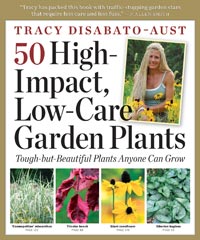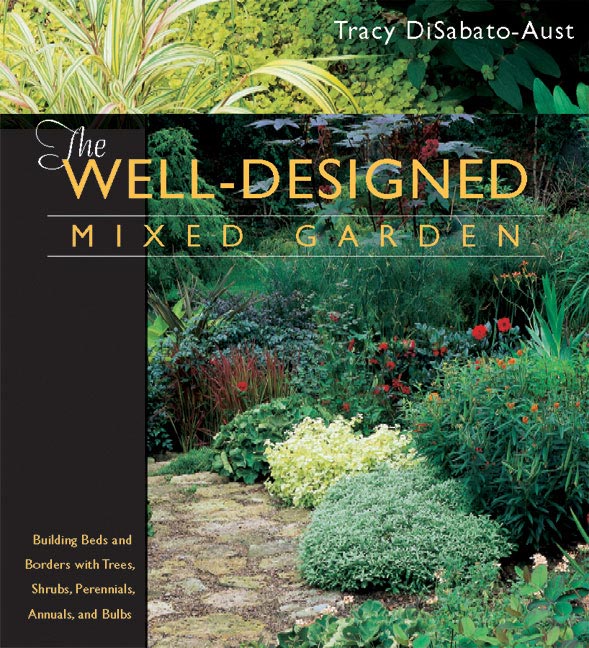
Last week I had the pleasure of speaking with Dean Fosdick, who writes for the Associated Press, about ways to save time and money in the garden. I hope to share his article with you sometime in March. In an earlier posting on this site (Feeling The Recession…)we looked at growing ornamental vegetables as a beautiful and thrifty gardening approach. Judy Lowe referenced it along with some other excellent budget-minded tips in her Christian Science Monitor article Money-saving gardening ideas //features.csmonitor.com/gardening/2009/02/16/money-saving-gardening-ideas/ I have postings on ornamental herbs and edible flowers that will arrive soon due to such high interest. But for now I wanted to share with you some of the things Dean and I discussed.
*Select high- impact, low-care plants (This is one of the main reasons I wrote my new book!!) Select plants that are long lived, cold, heat and humidity tolerant so we are not going to the great expense of replacing them. Gardeners waste tons of money and time by killing plants that are either not long lived or not the right choice for their site. Know your site—hardiness zone, soil etc (as I discussed in my earlier design blog and follow those design steps for success). I was thrilled to see Anne Raver’s article in The New York Times, “New This Year: The Tried and True” where the same theme rings out!!
//www.nytimes.com/2009/02/05/garden/05garden.html?_r=1&scp=7&sq=Dan%20Hinkley&st=cse
*Choose Resistant Plants: We save money, time, and invest in our environment by not having to use fertilizers, pesticides, fungicides, deer repellents or excess water by growing tough, resistant plants. (watch for upcoming blog)
*Prepare the soil with nutrient providing organic matter—Plants double or triple in size the first season (so smaller sizes of plants can be purchased) if the soil is prepared properly—create a living soil—so plants are less stressed, less prone to disease and insects—no band aid later with synthetic fertilizers or worse yet Death! (see: Well-Tended Perennial Garden for soil info) Compost yourself to save money but don’t skimp on this step as it will ensure success for countless years.
*Select plants that reseed (Assertively)— Plants that reseed “happily” not invasively (there is a huge difference) fill in space in the garden and thus fewer plants are required. Consider the free-seeding natives Wild-Oat (Chasmanthium latifolium) (photo) , or Bottlebrush Grass (Elymus hystrix) which are happy in wet or dry shade and finally fill in those spaces where you’ve killed numerous other species!!
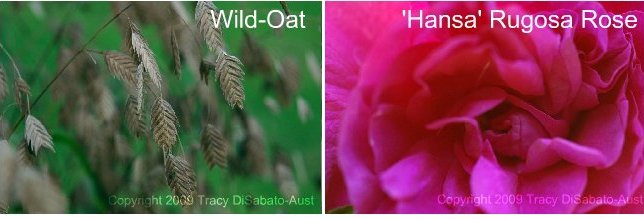
*Select plants that grow wide— “Big Bertha” plants should be “in”—“voluptuous is back?”—good news for Jessica Simpson, Heidi Klum (can you believe they have been called “heavy”?) and these large plants…wide growing plants fill in space and again you will need fewer plants in the garden. Think about the gorgeous ‘Gateway’ Joe Pye Weed (Eupatorium maculatum ‘Gateway’), and the fragrant ‘Hansa’ Rugosa Rose (Rosa rugosa ‘Hansa’) (photo) who can eventually spread to 4’or even 6’.
*Plant sharing— Be generous this year and share your plants with friends and family who may not be able to afford to buy their own. And don’t be afraid to ask for plants from friends if you see they have a large grouping of them. This works great with the above “assertive seeders”. I’ve given away countless Purple Coneflower (Echinacea purpurea) and Heliopsis (Heliopsis helianthoides) which also seed assertively. Hosta and daylilies divide easily with double-fork method (see video section) so make for easy sharing.
*Practice sound Horticulture:Learn Proper Pruning and Maintenance Techniques-Time is money—be fast and efficient in how you maintain your garden by using proper technique, tools etc. (See Well-Tended Perennial Garden for “cutting-edge” pruning tips)
I’m looking forward to your comments on some of your money saving gardening ideas!!
Tags: Anne Raver, Bottlebrush Grass, Christian Science Monitor, Dean Fosdick, Gateway Joe Pye Weed, Hansa Rugosa Rose, Heliopsis, hosta, money-saving garden ideas, New York Times, Purple Coneflower, Well-tended Perennial Garden, Wild-Oat
 Mike is the legendary voice of Chicago gardening and I will be on his radio show (820 on the AM dial) at 1pm Central (2pm Eastern) Get details at www.mikenowak.net and even if you’re not in Chicago, check out the WCPT internet stream at www.chicagoprogressivetalk.com.
Mike is the legendary voice of Chicago gardening and I will be on his radio show (820 on the AM dial) at 1pm Central (2pm Eastern) Get details at www.mikenowak.net and even if you’re not in Chicago, check out the WCPT internet stream at www.chicagoprogressivetalk.com. 

 Recently I had the opportunity to be a guest on Joe Lamp’l’s
Recently I had the opportunity to be a guest on Joe Lamp’l’s





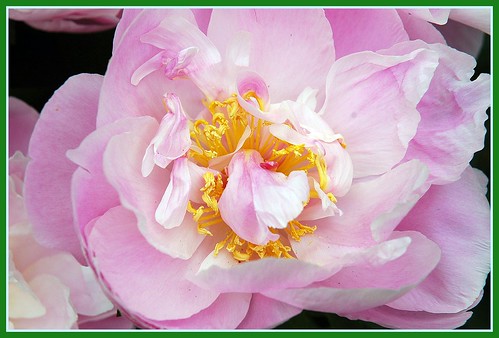 I’m often asked for publishing advice from people on gardening as well as non-gardening topics. I’m by no means the authority but I share what has worked for me with my three books…First you must truly believe in your topic and have a passion for it as well as lots of firsthand experience. Writing articles for various magazines, newsletters and even blogging is often a good way to start with topics you are interested in writing about in book form. See the response from these other venues first–learn what “issues” people are drawn to so you can accentuate those in your writing/marketing angle. Speaking on the topic is also a great way to make yourself the “expert” on it as well as to accurately learn people’s responses and see your weaknesses on the topic. Remember you have to learn in order to teach. Research you topics extensively and learn from other’s success and failure. What would make your book a contribution that’s not been offered before? There is a lot of ground work that goes down first before the book can be written. Try to find a publisher who will accept your proposal before you write the whole book or consider the pros/cons of self publishing. Once you commit to the book follow your dream and remain indomitable through the process. Then market with abandon, as it’s no use to have a book and a message to share if no one reads it!! Good Luck and Happy Writing!
I’m often asked for publishing advice from people on gardening as well as non-gardening topics. I’m by no means the authority but I share what has worked for me with my three books…First you must truly believe in your topic and have a passion for it as well as lots of firsthand experience. Writing articles for various magazines, newsletters and even blogging is often a good way to start with topics you are interested in writing about in book form. See the response from these other venues first–learn what “issues” people are drawn to so you can accentuate those in your writing/marketing angle. Speaking on the topic is also a great way to make yourself the “expert” on it as well as to accurately learn people’s responses and see your weaknesses on the topic. Remember you have to learn in order to teach. Research you topics extensively and learn from other’s success and failure. What would make your book a contribution that’s not been offered before? There is a lot of ground work that goes down first before the book can be written. Try to find a publisher who will accept your proposal before you write the whole book or consider the pros/cons of self publishing. Once you commit to the book follow your dream and remain indomitable through the process. Then market with abandon, as it’s no use to have a book and a message to share if no one reads it!! Good Luck and Happy Writing!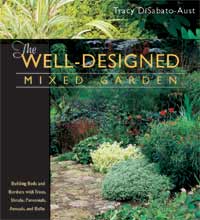 One of the most frequently asked questions I hear about garden design is “
One of the most frequently asked questions I hear about garden design is “ Where do I start?”. Any new venture… be it a new exercise program, a new writing project (blog?), or a new garden can cause us to freeze in our tracks. And revamping a pitiful existing garden can be even more overwhelming. So how can we get beyond the fear (Garden Design You are Not The Boss of Me!!) and enjoy this rewarding highly creative, artistic adventure? Any time we have a mapped out plan we seem to be able to “take on” whatever life throws us. Follow the steps below for success with your new or existing garden design. I go into great detail on this in Chapter 2 of The Well-Designed Mixed Garden .
Where do I start?”. Any new venture… be it a new exercise program, a new writing project (blog?), or a new garden can cause us to freeze in our tracks. And revamping a pitiful existing garden can be even more overwhelming. So how can we get beyond the fear (Garden Design You are Not The Boss of Me!!) and enjoy this rewarding highly creative, artistic adventure? Any time we have a mapped out plan we seem to be able to “take on” whatever life throws us. Follow the steps below for success with your new or existing garden design. I go into great detail on this in Chapter 2 of The Well-Designed Mixed Garden .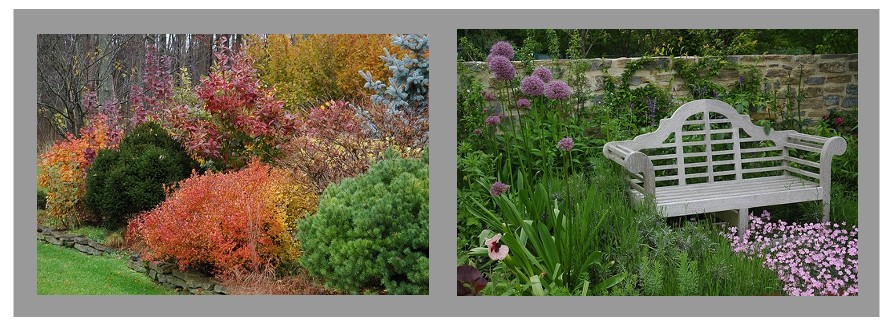
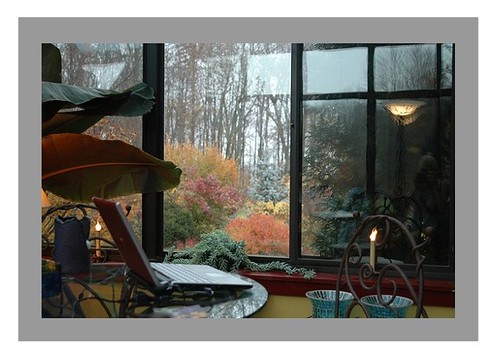 Will it be a free standing bed or will it be bordered by the house or a fence? How big should it be? (this goes back to how much time you have to work in the space—don’t get carried away with the size!!)
Will it be a free standing bed or will it be bordered by the house or a fence? How big should it be? (this goes back to how much time you have to work in the space—don’t get carried away with the size!!)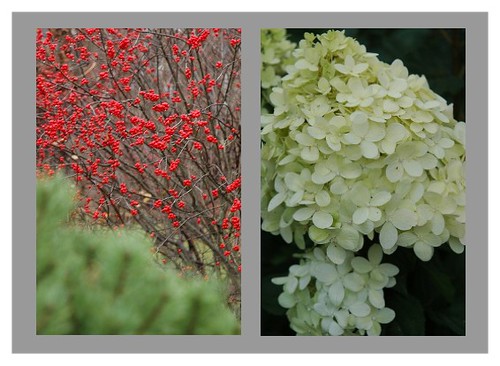

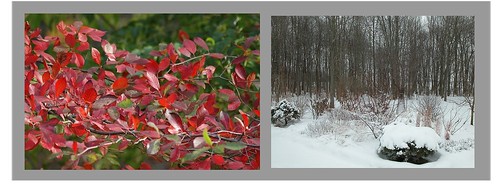
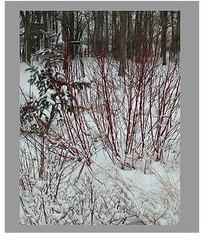 uld go (we all do this and support groups will soon be forming!!!). Remember FOCUS!! All of the above points come into play in selecting the right plants for the site, based on your maintenance needs, function, color/texture/form choices and season of interest. (Photos: For this border I selected plants for autumn/winter interest such as Midwinter Fire Dogwood and a Black Tupelo stands gracefully just outside the border.
uld go (we all do this and support groups will soon be forming!!!). Remember FOCUS!! All of the above points come into play in selecting the right plants for the site, based on your maintenance needs, function, color/texture/form choices and season of interest. (Photos: For this border I selected plants for autumn/winter interest such as Midwinter Fire Dogwood and a Black Tupelo stands gracefully just outside the border. Valentine’s Day is approaching — candy is bad for your waistline, cut flowers die, jewelry is expensive, and picking a perfume is a risk—Give a gift your honey can sink their teeth into without guilt and one that will last forever,yet not break the bank!! Give a gardening book!!
Valentine’s Day is approaching — candy is bad for your waistline, cut flowers die, jewelry is expensive, and picking a perfume is a risk—Give a gift your honey can sink their teeth into without guilt and one that will last forever,yet not break the bank!! Give a gardening book!!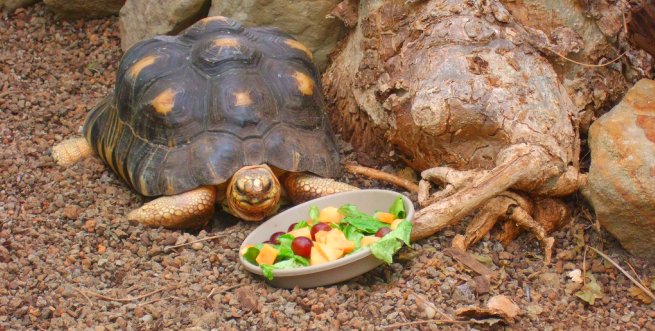
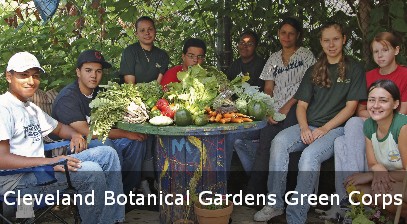 I was also “over- the- top impressed” with The Cleveland Botanical Garden’s cool urban youth program call Green Corps. It’s a work/study program for students aged 15-18 who earn as they learn by transforming vacant lots into flourishing urban farms. The students grow fruits, vegetables and flowers while also learning job and leadership skills, while being proactive in creating a healthier greener community for themselves and their neighbors. Students learn about sustainable urban farming, ecology, and healthy eating and growing as well as basics of entrepreneurship and sales. They sell their produce at farmer’s markets and bottle their own Ripe From Downtown® salsa. Let me tell you first hand it’s delicious!! Check out the Cleveland Botanical Garden at
I was also “over- the- top impressed” with The Cleveland Botanical Garden’s cool urban youth program call Green Corps. It’s a work/study program for students aged 15-18 who earn as they learn by transforming vacant lots into flourishing urban farms. The students grow fruits, vegetables and flowers while also learning job and leadership skills, while being proactive in creating a healthier greener community for themselves and their neighbors. Students learn about sustainable urban farming, ecology, and healthy eating and growing as well as basics of entrepreneurship and sales. They sell their produce at farmer’s markets and bottle their own Ripe From Downtown® salsa. Let me tell you first hand it’s delicious!! Check out the Cleveland Botanical Garden at 
![Reblog this post [with Zemanta]](http://img.zemanta.com/reblog_e.png?x-id=5d7d9a51-da96-4481-ad93-e074b409782c)
 The January 2009 lectures launching 50 High-Impact, Low-Care Plants have been fun and exciting. I kicked things off with the Landscape Contractors Association in Maryland. We had 3.5 hours to discuss Tough But Beautiful Plants and the importance of “spreading the word” of all the mental, physical, and emotional benefits of gardening with dynamic yet sustainable plants. I flew from Maryland to West Virginia to talk with the West Virginia Nursery and Landscape Association. The hour flew by there and then I went to Taylor Books, Charleston, WV for a signing. What a treat to find out that the owner Ann Saville had an interesting rooftop garden featuring several of the “50 Plants” in my new book. (see photos). A day later I was back in Columbus Ohio for the annual P.L.A.N.T. day sponsored by the Perennial Plant Association, The Ohio State University Master Gardener Volunteers, and my mentor Steven Still (see photo). What an honor to launch this new book as I had launched The Well-Tended Perennial Garden 11 years ago and The Well-Designed Mixed Garden 6 years ago. Lots of my long time gardening friends and associates attended the event and it was great to share in the joy of this new topic. The following morning I spoke at The Ohio State University Nursery Short Course and again it was a treat to be with so many colleagues. On Friday of that week I was the keynote speaker for The Western New York State Nursery and Landscape Association in Hamburg NY. Attendance was good despite yet more snow overnight and it was great to have not only professionals but numerous students in the audience. The Buffalo News ran a nice article that morning (see inset) as did GardenRant.com in the days that followed. I’d like to thank all the sponsors of these talks for their support and commitment to education.
The January 2009 lectures launching 50 High-Impact, Low-Care Plants have been fun and exciting. I kicked things off with the Landscape Contractors Association in Maryland. We had 3.5 hours to discuss Tough But Beautiful Plants and the importance of “spreading the word” of all the mental, physical, and emotional benefits of gardening with dynamic yet sustainable plants. I flew from Maryland to West Virginia to talk with the West Virginia Nursery and Landscape Association. The hour flew by there and then I went to Taylor Books, Charleston, WV for a signing. What a treat to find out that the owner Ann Saville had an interesting rooftop garden featuring several of the “50 Plants” in my new book. (see photos). A day later I was back in Columbus Ohio for the annual P.L.A.N.T. day sponsored by the Perennial Plant Association, The Ohio State University Master Gardener Volunteers, and my mentor Steven Still (see photo). What an honor to launch this new book as I had launched The Well-Tended Perennial Garden 11 years ago and The Well-Designed Mixed Garden 6 years ago. Lots of my long time gardening friends and associates attended the event and it was great to share in the joy of this new topic. The following morning I spoke at The Ohio State University Nursery Short Course and again it was a treat to be with so many colleagues. On Friday of that week I was the keynote speaker for The Western New York State Nursery and Landscape Association in Hamburg NY. Attendance was good despite yet more snow overnight and it was great to have not only professionals but numerous students in the audience. The Buffalo News ran a nice article that morning (see inset) as did GardenRant.com in the days that followed. I’d like to thank all the sponsors of these talks for their support and commitment to education.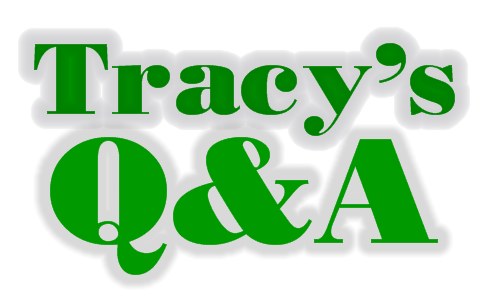 I hope to share with you along the way some of the frequently asked questions from lecture participants as I’m sure they may be some of the same questions you have.
I hope to share with you along the way some of the frequently asked questions from lecture participants as I’m sure they may be some of the same questions you have.

